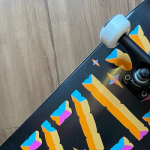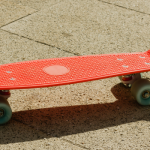Longboarding is a thrilling sport that has been rapidly gaining popularity over the past few years. It’s often seen as the laid-back cousin of skateboarding, mainly focused on cruising and downhill racing.
However, many adventurous souls have started to push the boundaries of what’s possible with a longboard, incorporating impressive tricks and maneuvers into their rides. This has sparked a fascinating question: Can you do skateboard tricks on a longboard?
Absolutely, Despite their size and design, longboards are surprisingly versatile and can perform a wide range of tricks. However, mastering these tricks requires a unique blend of balance, technique, and courage.
In this article, we’ll explore the world of longboard tricks, offering tips for those eager to take their longboarding skills to the next level. So grab your helmet and kneepads, and get ready to ride the wave of excitement that is longboard trick riding.
Quick Guide: Yes, you can perform skateboard tricks on a longboard! While longboards are traditionally associated with cruising and transportation due to their stability and smooth ride, riders have pushed the boundaries and demonstrated that longboards can also be used for various tricks. However, it’s important to note that longboard tricks may differ from traditional skateboard tricks due to the unique characteristics of longboards.
Fundamental Longboard Tricks:
Before attempting any advanced tricks, it’s essential to master the fundamental longboard tricks. These basic maneuvers are the building blocks of more complex tricks and will help you develop the necessary balance and control.
Manuals and Nose Manuals:
Weight Distribution:
In longboarding, a manual refers to lifting either the front (nose) or back (tail) wheels off the ground while riding on the other set of wheels. This trick heavily relies on understanding and manipulating weight distribution.
- Executing a Manual:
- For a manual, shift your weight backward towards the tail of the board.
- To perform a nose manual, shift your weight forward towards the nose.
- Finding the Balance Point:
- Experiment to find the sweet spot where the board balances on either set of wheels.
- Practice maintaining balance through slight adjustments in weight distribution.
Carving:
Initiating Smooth Turns:
Carving is a fundamental skill that involves making smooth, flowing turns while riding.
- Body Movements:
- Initiate turns by leaning into them. For a heelside turn, lean on your heels, and for a toeside turn, lean on your toes.
- Allow your body to follow the curve of the turn naturally.
- Adapting to Different Terrains:
- On flat surfaces, focus on using your body to guide the board through turns.
- On slopes, use carving to control speed and navigate smoothly.
Pivots:
Frontside and Backside Pivots:
Pivoting involves turning the board on its axis without moving your feet.
- Foot Positioning:
- For a frontside pivot, place more weight on your front foot and pivot the board using your back foot.
- For a backside pivot, shift weight to the back foot and use the front foot to guide the pivot.
- Practice Drills:
- Start with small pivots and gradually increase the angle as you become more comfortable.
- Practice on a flat, open surface to focus on the mechanics of the pivot.
Practice Drills for Mastery:
- Circles and Figure Eights:
- Create circles or figure eights by pivoting the board in both directions.
- This helps develop control and coordination.
Pivot Variation:
- Nose Pivot:
- Similar to a nose manual, but with the focus on rotating the board around the front wheels.
- Requires precise weight distribution and control.
Combining Pivots with Other Tricks:
- Once comfortable with pivots, experiment with integrating them into slides, manuals, or other tricks.
- Pivots add style and fluidity to your overall longboarding repertoire.
Safety Precautions:
Now, prioritizing safety is paramount to enjoying the sport to its fullest. Here are five crucial safety precautions to keep in mind:
Protective Gear is Non-Negotiable:
Helmets: Always wear a certified helmet designed for skateboarding. It protects the most critical part of your body — your head — from potential impact during falls.
Knee Pads and Elbow Pads: Protect your joints by wearing knee and elbow pads. These will reduce the risk of abrasions, cuts, and injuries during slides and falls.
Mind Your Terrain:
Smooth Pavement vs. Rough Terrain: Choose your riding terrain wisely. While smooth pavement is ideal for tricks, rough or uneven surfaces may increase the likelihood of accidents. Be aware of the conditions and adjust your riding style accordingly.
Obstacles and Traffic: Always be vigilant about your surroundings. Watch out for obstacles such as rocks, potholes, or debris on the road. Additionally, be cautious of vehicular and pedestrian traffic.
Learn and Execute Tricks Gradually:
Setting Realistic Goals: Progression is key. Set achievable goals and gradually work your way up to more advanced tricks. Rushing into complex maneuvers without mastering the basics increases the risk of accidents.
Consistent Practice: Practice regularly but be mindful of your skill level. Trying tricks beyond your current ability might lead to falls and injuries.
Check and Maintain Your Equipment:
Regular Inspections: Before each session, inspect your longboard for any signs of wear and tear. Ensure that all components, including trucks, wheels, and bearings, are in good condition. Replace any damaged parts promptly.
Tighten and Adjust: Keep your trucks tightened to an appropriate level. Loose trucks may result in instability, while overly tight trucks can limit maneuverability. Find a balance that suits your riding style.
Be Weather-Aware:
Wet and Slippery Conditions: Avoid riding in wet or slippery conditions. Wet pavement significantly reduces traction, making it more challenging to control the board. If you encounter unexpected rain, find shelter until conditions improve.
Adapt to Environmental Changes: Be aware of changes in weather, temperature, and visibility. Adjust your riding style to accommodate variations in terrain and visibility caused by factors like low light or fog.
By adhering to these safety precautions, you not only minimize the risk of accidents and injuries but also enhance your overall longboarding experience.
Conclusion
Wraps up the guide by encouraging readers to embrace the challenge, push their limits, and use their longboards as a canvas for creativity. It reiterates the importance of understanding the longboard, practicing diligently, prioritizing safety, and gradually progressing through skill levels to become a skilled longboard trickster.
![Why do skateboarders hate scooters? [Reasons + Tips] Why do skateboarders hate scooters? [Reasons + Tips]](https://bedoper.site/wp-content/uploads/2023/04/Why-do-skateboarders-hate-scooters-150x150.png)


![How fast do skateboards go downhill? [90 mph (145 km/h)] How fast do skateboards go downhill? [90 mph (145 km/h)]](https://bedoper.site/wp-content/uploads/2023/04/How-fast-do-skateboards-go-downhill-150x150.png)
